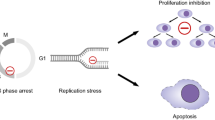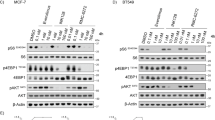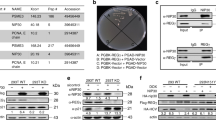Abstract
Small-molecule multi-_targeted cyclin-dependent kinase (CDK) inhibitors (CDKIs) are of particular interest due to their potent antitumor activity independent of p53 gene alterations. P53 deletion is associated with a very poor prognosis in multiple myeloma (MM). In this regard, we tested the anti-MM activity of RGB-286638, an indenopyrazole-derived CDKI with Ki-nanomolar activity against transcriptional CDKs. We examined RGB-286638’s mode-of-action in MM cell lines with wild-type (wt)-p53 and those expressing mutant p53. RGB-286638 treatment resulted in MM cytotoxicity in vitro associated with inhibition of MM tumor growth and prolonged survival in vivo. RGB-286638 displayed caspase-dependent apoptosis in both wt-p53 and mutant-p53 cells that was closely associated with the downregulation of RNA polymerase II phosphorylation and inhibition of transcription. RGB-286638 triggered p53 accumulation via nucleolar stress and loss of Mdm2, accompanied by induction of p53 DNA-binding activity. In addition, RGB-286638 mediated p53-independent activity, which was confirmed by cytotoxicity in p53-knockdown and p53-mutant cells. We also demonstrated downregulation of oncogenic miR-19, miR-92a-1 and miR-21. Our data provide the rationale for the development of transcriptional CDKIs as therapeutic agents, which activate p53 in competent cells, while circumventing p53 deficiency through alternative p53-independent cell death mechanisms in p53-mutant/deleted cells.
This is a preview of subscription content, access via your institution
Access options
Subscribe to this journal
Receive 12 print issues and online access
We are sorry, but there is no personal subscription option available for your country.
Buy this article
- Purchase on SpringerLink
- Instant access to full article PDF
Prices may be subject to local taxes which are calculated during checkout






Similar content being viewed by others
References
Malumbres M, Harlow E, Hunt T, Hunter T, Lahti JM, Manning G et al. Cyclin-dependent kinases: a family portrait. Nat Cell Biol 2009; 11: 1275–1276.
Malumbres M, Barbacid M . Cell cycle, CDKs and cancer: a changing paradigm. Nature Rev. Cancer 2009; 9: 153–166.
Pinhero R, Liaw P, Bertens K, Yankulov K . Three cyclin-dependent kinases preferentially phosphorylate different parts of the C-terminal domain of the large subunit of RNA polymerase II. Eur J Biochem 2004; 271: 1004–1014.
Romano G, Giordano A . Role of the cyclin-dependent kinase 9-related pathway in mammalian gene expression and human diseases. Cell Cycle 2008; 7: 3664–3668.
Bergsagel PL, Kuehl W.M . Molecular pathogenesis and a consequent classification of multiple myeloma. J Clin Oncol 2005; 23: 6333–6338.
Canavese M, Santo L, Raje N . Cyclin dependent kinases in cancer: potential for therapeutic intervention. Cancer Biol Ther 2012; 13: 451–457.
Kramer A, Schultheis B, Bergmann J, Willer A, Hegenbart U, Ho AD et al. Alterations of the cyclin D1/pRb/p16(INK4A) pathway in multiple myeloma. Leukemia 2002; 16: 1844–1851.
Baughn LB, Di Liberto M, Wu K, Toogood PL, Louie T, Gottschalk R et al. A novel orally active small molecule potently induces G1 arrest in primary myeloma cells and prevents tumor growth by specific inhibition of cyclin-dependent kinase 4/6. Cancer Res 2006; 66: 7661–7667.
Raje N, Kumar S, Hideshima T, Roccaro A, Ishitsuka K, Yasui H et al. Seliciclib (CYC202 or R-roscovitine), a small-molecule cyclin-dependent kinase inhibitor, mediates activity via down-regulation of Mcl-1 in multiple myeloma. Blood 2005; 106: 1042–1047.
Raje N, Hideshima T, Mukherjee S, Raab M, Vallet S, Chhetri S et al. Preclinical activity of P276-00, a novel small-molecule cyclin-dependent kinase inhibitor in the therapy of multiple myeloma. Leukemia 2009; 23: 961–970.
Santo L, Vallet S, Hideshima T, Cirstea D, Ikeda H, Pozzi S et al. AT7519, A novel small molecule multi-cyclin-dependent kinase inhibitor, induces apoptosis in multiple myeloma via GSK-3beta activation and RNA polymerase II inhibition. Oncogene 2010; 29: 2325–2336.
Ljungman M, Zhang F, Chen F, Rainbow AJ, McKay BC . Inhibition of RNA polymerase II as a trigger for the p53 response. Oncogene 1999; 18: 583–592.
Wang S, Griffiths G, Midgley CA, Barnett AL, Cooper M, Grabarek J et al. Discovery and characterization of 2-anilino-4- (thiazol-5-yl)pyrimidine transcriptional CDK inhibitors as anticancer agents. Chem Biol 2010; 17: 1111–1121.
Blagosklonny MV, Demidenko ZN, Fojo T . Inhibition of transcription results in accumulation of Wt p53 followed by delayed outburst of p53-inducible proteins: p53 as a sensor of transcriptional integrity. Cell cycle 2002; 1: 67–74.
Avet-Loiseau H, Attal M, Moreau P, Charbonnel C, Garban F, Hulin C et al. Genetic abnormalities and survival in multiple myeloma: the experience of the Intergroupe Francophone du Myelome. Blood 2007; 109: 3489–3495.
Jakubowiak AJ, Siegel DS, Martin T, Wang M, Vij R, Lonial S et al. Treatment outcomes in patients with relapsed and refractory multiple myeloma and high-risk cytogenetics receiving single-agent carfilzomib in the PX-171-003-A1 study. Leukemia 2013; e-pub ahead of print 7 June 2013; doi:10.1038/leu.2013.152.
Tai YT, Teoh G, Shima Y, Chauhan D, Treon SP, Raje N et al. Isolation and characterization of human multiple myeloma cell enriched populations. J Immunol Methods 2000; 235: 11–19.
Scullen T, Santo L, Vallet S, Fulciniti M, Eda H, Cirstea D et al. Lenalidomide in combination with an activin A-neutralizing antibody: preclinical rationale for a novel anti-myeloma strategy. Leukemia 2013; e-pub ahead of print 12 March 2013; doi:10.1038/leu.2013.50.
Mestdagh P, Feys T, Bernard N, Guenther S, Chen C, Speleman F et al. High-throughput stem-loop RT-qPCR miRNA expression profiling using minute amounts of input RNA. Nucleic Acids Res 2008; 36: e143.
Chen Y, Gelfond JA, McManus LM, Shireman PK . Reproducibility of quantitative RT-PCR array in miRNA expression profiling and comparison with microarray analysis. BMC Genomics 2009; 10: 407.
de Bruijn P, Moghaddam-Helmantel IM, de Jonge MJ, Meyer T, Lam MH, Verweij J et al. Validated bioanalytical method for the quantification of RGB-286638, a novel multi-_targeted protein kinase inhibitor, in human plasma and urine by liquid chromatography/tandem triple-quadrupole mass spectrometry. J Pharm Biomed Anal 2009; 50: 977–982.
Palancade B, Bensaude O . Investigating RNA polymerase II carboxyl-terminal domain (CTD) phosphorylation. Eur J Biochem 2003; 270: 3859–3870.
Sims RJ 3rd, Belotserkovskaya R, Reinberg D . Elongation by RNA polymerase II: the short and long of it. Genes Devt 2004; 18: 2437–2468.
Podar K, Chauhan D, Anderson KC . Bone marrow microenvironment and the identification of new _targets for myeloma therapy. Leukemia 2009; 23: 10–24.
van de Donk NW, Lokhorst HM, Bloem AC . Growth factors and antiapoptotic signaling pathways in multiple myeloma. Leukemia 2005; 19: 2177–2185.
Shav-Tal Y, Blechman J, Darzacq X, Montagna C, Dye BT, Patton JG et al. Dynamic sorting of nuclear components into distinct nucleolar caps during transcriptional inhibition. Mol Biol Cell 2005; 16: 2395–2413.
Sirri V, Urcuqui-Inchima S, Roussel P, Hernandez-Verdun D . Nucleolus: the fascinating nuclear body. Histochem Cell Biol 2008; 129: 13–31.
Chao C, Saito S, Kang J, Anderson CW, Appella E, Xu Y . p53 transcriptional activity is essential for p53-dependent apoptosis following DNA damage. EMBO J 2000; 19: 4967–4975.
Pichiorri F, De Luca L, Aqeilan RI . MicroRNAs: new players in multiple myeloma. Front Genet 2011; 2: 22.
Corthals SL, Sun SM, Kuiper R, de Knegt Y, Broyl A, van der Holt B et al. MicroRNA signatures characterize multiple myeloma patients. Leukemia 2011; 25: 1784–1789.
Loffler D, Brocke-Heidrich K, Pfeifer G, Stocsits C, Hackermuller J, Kretzschmar AK et al. Interleukin-6 dependent survival of multiple myeloma cells involves the Stat3-mediated induction of microRNA-21 through a highly conserved enhancer. Blood 2007; 110: 1330–1333.
Pichiorri F, Suh SS, Ladetto M, Kuehl M, Palumbo T, Drandi D et al. MicroRNAs regulate critical genes associated with multiple myeloma pathogenesis. Proc Natl Acad Sci USA 2008; 105: 12885–12890.
Kluiver J, Kroesen BJ, Poppema S, van den Berg A . The role of microRNAs in normal hematopoiesis and hematopoietic malignancies. Leukemia 2006; 20: 1931–1936.
Krystof V, Uldrijan S . Cyclin-dependent kinase inhibitors as anticancer drugs. Curr Drug _targets 2010; 11: 291–302.
Krystof V, Baumli S, Furst R . Perspective of cyclin-dependent kinase 9 (CDK9) as a drug _target. Curr Pharm Des 2012; 18: 2883–2890.
Simone C, Bagella L, Bellan C, Giordano A . Physical interaction between pRb and cdk9/cyclinT2 complex. Oncogene 2002; 21: 4158–4165.
Lu W, Chen L, Peng Y, Chen J . Activation of p53 by roscovitine-mediated suppression of MDM2 expression. Oncogene 2001; 20: 3206–3216.
O'Hagan HM, Ljungman M . Nuclear accumulation of p53 following inhibition of transcription is not due to diminished levels of MDM2. Oncogene 2004; 23: 5505–5512.
Dai MS, Lu H . Inhibition of MDM2-mediated p53 ubiquitination and degradation by ribosomal protein L5. J Biol Chem 2004; 279: 44475–44482.
Zhang Y, Wolf GW, Bhat K, Jin A, Allio T, Burkhart WA et al. Ribosomal protein L11 negatively regulates oncoprotein MDM2 and mediates a p53-dependent ribosomal-stress checkpoint pathway. Mol Cell Biol 2003; 23: 8902–8912.
Dai MS, Zeng SX, Jin Y, Sun XX, David L, Lu H . Ribosomal protein L23 activates p53 by inhibiting MDM2 function in response to ribosomal perturbation but not to translation inhibition. Mol Cell Biol 2004; 24: 7654–7668.
Acknowledgements
This study was supported by Grant CDA SPORE and NIH/NCI Grant no. P50 CA100707. RGB-286638 compound was provided by Agennix USA Inc.
Author information
Authors and Affiliations
Corresponding author
Ethics declarations
Competing interests
Hannes Loferer is the Agennix AG employee. The remaining authors declare no conflict of interest.
Additional information
Supplementary Information accompanies this paper on the Leukemia website
Rights and permissions
About this article
Cite this article
Cirstea, D., Hideshima, T., Santo, L. et al. Small-molecule multi-_targeted kinase inhibitor RGB-286638 triggers P53-dependent and -independent anti-multiple myeloma activity through inhibition of transcriptional CDKs. Leukemia 27, 2366–2375 (2013). https://doi.org/10.1038/leu.2013.194
Received:
Revised:
Accepted:
Published:
Issue Date:
DOI: https://doi.org/10.1038/leu.2013.194
Keywords
This article is cited by
-
Novel CDK9 inhibitor oroxylin A promotes wild-type P53 stability and prevents hepatocellular carcinoma progression by disrupting both MDM2 and SIRT1 signaling
Acta Pharmacologica Sinica (2022)
-
Synthesis and biological evaluation of seliciclib derivatives as potent and selective CDK9 inhibitors for prostate cancer therapy
Monatshefte für Chemie - Chemical Monthly (2021)
-
Clinical utility of recently identified diagnostic, prognostic, and predictive molecular biomarkers in mature B-cell neoplasms
Modern Pathology (2017)
-
Preclinical activity of CPI-0610, a novel small-molecule bromodomain and extra-terminal protein inhibitor in the therapy of multiple myeloma
Leukemia (2017)
-
Class IIa HDAC inhibition enhances ER stress-mediated cell death in multiple myeloma
Leukemia (2015)



